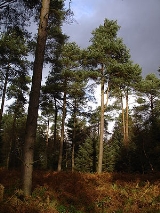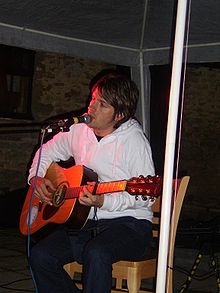
Dalby Forest
Encyclopedia

North Yorkshire
North Yorkshire is a non-metropolitan or shire county located in the Yorkshire and the Humber region of England, and a ceremonial county primarily in that region but partly in North East England. Created in 1974 by the Local Government Act 1972 it covers an area of , making it the largest...
, England
England
England is a country that is part of the United Kingdom. It shares land borders with Scotland to the north and Wales to the west; the Irish Sea is to the north west, the Celtic Sea to the south west, with the North Sea to the east and the English Channel to the south separating it from continental...
. It is maintained by the UK Forestry Commission
Forestry Commission
The Forestry Commission is a non-ministerial government department responsible for forestry in Great Britain. Its mission is to protect and expand Britain's forests and woodlands and increase their value to society and the environment....
. Dalby Forest, along with Langdale Forest and Cropton Forest, forms part of the North Riding Forest Park, found within the North York Moors National Park.
Botany
Dalby Forest is home to many species of wildlife such as badgers, roe deerRoe Deer
The European Roe Deer , also known as the Western Roe Deer, chevreuil or just Roe Deer, is a Eurasian species of deer. It is relatively small, reddish and grey-brown, and well-adapted to cold environments. Roe Deer are widespread in Western Europe, from the Mediterranean to Scandinavia, and from...
and nightjars. There are also many species of trees including oak
Oak
An oak is a tree or shrub in the genus Quercus , of which about 600 species exist. "Oak" may also appear in the names of species in related genera, notably Lithocarpus...
, beech
Beech
Beech is a genus of ten species of deciduous trees in the family Fagaceae, native to temperate Europe, Asia and North America.-Habit:...
, ash
Ash tree
Fraxinus is a genus flowering plants in the olive and lilac family, Oleaceae. It contains 45-65 species of usually medium to large trees, mostly deciduous though a few subtropical species are evergreen. The tree's common English name, ash, goes back to the Old English æsc, while the generic name...
, alder
Alder
Alder is the common name of a genus of flowering plants belonging to the birch family . The genus comprises about 30 species of monoecious trees and shrubs, few reaching large size, distributed throughout the North Temperate Zone and in the Americas along the Andes southwards to...
and hazel
Hazel
The hazels are a genus of deciduous trees and large shrubs native to the temperate northern hemisphere. The genus is usually placed in the birch family Betulaceae, though some botanists split the hazels into a separate family Corylaceae.They have simple, rounded leaves with double-serrate margins...
.
History
There is evidence of people living in Dalby Forest since the Bronze Age. Burial mounds, linearLinear
In mathematics, a linear map or function f is a function which satisfies the following two properties:* Additivity : f = f + f...
earthworks
Earthworks (archaeology)
In archaeology, earthwork is a general term to describe artificial changes in land level. Earthworks are often known colloquially as 'lumps and bumps'. Earthworks can themselves be archaeological features or they can show features beneath the surface...
of unknown purpose and the remains of a flourishing rabbit
Rabbit
Rabbits are small mammals in the family Leporidae of the order Lagomorpha, found in several parts of the world...
warrening
Warren (free)
Free warren—often simply warren—refers to a type of franchise or privilege conveyed by a sovereign in mediaeval England to a subject, promising to hold them harmless for killing game of certain species within a stipulated area, usually a wood or small forest...
industry have also been found throughout the woods.
During the 1930s, unemployed men were set to work in Dalby Forest, breaking ground, building tracks and undertaking other heavy labour. The men lived in a work camp at Low Dalby, which was one of a number of so-called Instructional Centres run by the Ministry of Labour
Ministry of Labour
The Ministry of Labour was a British civil service department established by the New Ministries and Secretaries Act 1916. It was renamed the Employment Department in 1988, and finally abolished in 1995...
in order to 'harden' young men who had been out of work for some time. By 1938, the Ministry was operating 35 Instructional Centres across Britain with a total capacity of over 6,000 places.
By 1939, unemployment was declining in the face of impending war and the Ministry closed down its work camps. However, much of Dalby village seems to be based partly on the layout of the old Instructional Centre.
Recreation
Today, Dalby Forest is used for recreation as well as timber production. There are several car parks, hiking trails and mountain bike trails, a 'forest drive' throughout the forest and a Go ApeGo Ape
Go Ape Ltd. is an outdoor pursuits company which runs 26 high wire adventure courses in forests in England, Scotland and Wales consisting of rope ladders, zip-lines, rope bridges, trapezes and swings...
centre. A toll is charged to enter the forest by car, although parking is free. The main visitor centre has a café and shop, which is adjacent to a selection of other businesses including a bike shop and various craft workshops.
Mountain bike trails correspond to the standard IMBA
International Mountain Bicycling Association
The International Mountain Bicycling Association is a non-profit educational association whose mission is to create, enhance and preserve trail opportunities for mountain bikers worldwide....
and Forestry Commission grading scheme. Some start from the main visitor centre, others from Dixons Hollow, an area a little further along the forest drive. They include:
- Two green trails, one starting from the visitor centre and one from Dixons Hollow. The green trails follow forestry roads for the duration of the trail, and as suggested by the IMBA, require a minimal amount of fitness and are suitable for families.
- A blue trail starting from the visitor centre.
- A red trail starting from Dixons Hollow. This is the longest trail and explores much of the forest. It passes nearby the visitor centre and can be accessed from it. The red trail is technical in places and requires a high level of fitness and technical proficiency. A hardtail mountain bike of a moderate spec is advised to tackle this trail.
- A black trail starting from Dixons Hollow. The black trail is highly technical with some extremely severe descents requiring a very high level of skill and fitness. Please be advised that on the newer sections of the trail there are a number of blind 3–5 ft drops which can cause serious injury if approached unaware, or at a high speed.
- A "slope-style" area at Dixons Hollow, including jumps, a corkscrew, northshore and skinnies. This has been sponsored by Pace Cycles and constructed in association with SingletrAction.
The trickier trails deliberately start from Dixons Hollow, a little remote from the main visitor centre, to discourage inexperienced mountain bikers.
In 2010 the forest hosted the cross-country section of the UCI Mountain Bike World Cup.
External links
- Forestry Commission
- Dalby Forest at the Forestry Commission
- Lee Garland Photography shots of Dalby Forest Visitor Centre, "From Small Acorns.." September 2007
- Dalby Forest Red Mountain Bike Route Map, photos and description of Red Route.
- Dalby Forest Black Mountain Bike Route Map, photos and description of Black Route.

